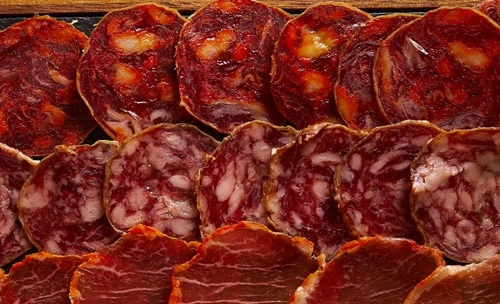Chorizo and longaniza are two flavorful sausages that are staples in Spanish, Latin American, and Filipino cuisines. While they share similarities in ingredients and preparation methods, they have distinct characteristics that set them apart, including differences in flavor, texture, preparation, and culinary uses. Understanding the difference between chorizo and longaniza is essential for anyone exploring the diverse world of sausages.
This article explores their origins, ingredients, preparation techniques, and culinary applications, helping you identify and appreciate the unique qualities of each.
What Is Chorizo?

Chorizo is a highly seasoned sausage made primarily from ground pork, though variations may use other meats like beef. Originating in Spain, it has become a beloved ingredient across many cuisines, particularly in Latin America.
Key Characteristics of Chorizo
- Texture: Typically made with coarsely ground meat, giving it a chunky and firm texture.
- Casing: Often encased in natural or synthetic casings.
- Flavor: Highly spiced with ingredients like smoked paprika (pimentón), garlic, and herbs. Spanish chorizo is typically smoky, while Latin American chorizo tends to be spicier.
- Cooking Style: Can be cured (ready to eat) or raw (requires cooking).
- Appearance: Red-orange color due to paprika and other spices.
Types of Chorizo
- Spanish Chorizo: Cured or semi-cured, often sliced and eaten as-is or added to dishes.
- Mexican Chorizo: Fresh and raw, needing to be cooked before consumption, often crumbled into dishes.
What Is Longaniza?
Longaniza is another type of sausage made from minced or finely ground meat, typically pork, though beef, chicken, and other meats are also used depending on the region. Like chorizo, it has variations across Spain, Latin America, and the Philippines.
Key Characteristics of Longaniza
- Texture: Made with finely minced meat, resulting in a smoother texture compared to chorizo.
- Casing: Encased in natural or synthetic casings, often longer than chorizo links.
- Flavor: Seasoned with a wide variety of spices, which vary by region. Longaniza typically has a milder or sweeter flavor profile compared to chorizo.
- Cooking Style: Primarily raw and needs to be cooked before consumption.
- Appearance: Color can range from red to light brown, depending on the seasoning and preparation.
Regional Varieties
- Spanish Longaniza: Similar to Spanish chorizo but with different spices.
- Filipino Longganisa: Often sweet (hamonado) or garlicky (de recado), made with additional sugar, vinegar, and garlic.
Key Differences Between Chorizo and Longaniza
| Aspect | Chorizo | Longaniza |
|---|---|---|
| Meat Texture | Coarsely ground meat. | Finely minced or ground meat. |
| Flavor | Spicy, smoky, or robust, depending on the region. | Milder or sweeter, with a focus on regional spices. |
| Cooking Style | Can be cured (ready-to-eat) or raw (requires cooking). | Usually raw and needs cooking before eating. |
| Casing Length | Shorter, often in links. | Longer, often in continuous coils or long links. |
| Color | Red or orange from paprika and spices. | Varies, from red to light brown. |
| Regional Use | Popular in Spain, Mexico, and Latin America. | Common in Spain, Latin America, and the Philippines. |
| Usage | Often crumbled, sliced, or eaten as-is. | Usually sliced or cooked whole. |
1. Ingredients
Chorizo
- Chorizo recipes emphasize bold spices such as smoked paprika, garlic, cumin, oregano, and chili peppers.
- Pork fat is often added for flavor and moisture, making the sausage rich and succulent.
- Spanish chorizo commonly uses dry wine, while Latin American versions may include vinegar.
Longaniza
- Longaniza incorporates a broader variety of regional spices. For example:
- Spanish longaniza: Seasoned with black pepper, nutmeg, or cloves.
- Filipino longganisa: Features a sweet and savory combination of sugar, vinegar, and garlic.
- Depending on the country, annatto seeds (achiote) or other coloring agents may be added to enhance appearance.
2. Texture and Preparation
Chorizo
- The coarse grind of meat gives chorizo a firmer, chunkier texture.
- Spanish chorizo is often cured or smoked, allowing it to be eaten without cooking. In contrast, Mexican chorizo is fresh and must be cooked, often crumbled into dishes.
Longaniza
- The finely minced meat in longaniza creates a smoother and softer texture.
- Typically sold raw, longaniza needs to be cooked before eating. It is often sliced or cooked as a whole link, depending on the dish.
3. Flavor Profile
Chorizo
- Smoky and robust, thanks to the heavy use of paprika and garlic.
- Mexican chorizo often leans toward spiciness due to the addition of chili peppers.
- Spanish chorizo can be sweet or spicy, depending on the variety of paprika used.
Longaniza
- Generally milder than chorizo, with variations ranging from sweet to garlicky or tangy.
- The flavor profile changes drastically by region. For example:
- Filipino longganisa hamonado: Sweet and garlicky.
- Latin American longaniza: Spiced with annatto, vinegar, or black pepper.
4. Regional Variations
Chorizo
- Spanish Chorizo: Firm and often sliced, eaten as a snack or tapa. Common in dishes like paella or served alongside cheese and wine.
- Mexican Chorizo: Soft and crumbly, used in tacos, burritos, and breakfast dishes like huevos con chorizo.
Longaniza
- Filipino Longganisa: Sweet, garlicky, and often paired with rice, eggs, and pickled vegetables (longsilog breakfast).
- Latin American Longaniza: Common in countries like the Dominican Republic, Puerto Rico, and Argentina, often grilled or fried.
5. Cooking Methods
Chorizo
- Spanish Chorizo: Can be eaten raw (if cured), grilled, fried, or added to stews and soups.
- Mexican Chorizo: Always cooked, often crumbled and sautéed before adding to recipes.
Longaniza
- Typically cooked whole, either grilled, fried, or boiled. It may also be sliced and added to stews or rice dishes.
6. Culinary Uses
Chorizo
- Adds a burst of flavor to soups, stews, and casseroles.
- Crumbled chorizo is a favorite topping for tacos, pizzas, and nachos.
- Eaten as a snack or appetizer when cured.
Longaniza
- Commonly served with rice and eggs as a hearty breakfast dish.
- Sliced and added to soups, stews, or stir-fries.
- Grilled or fried and served with dipping sauces.
7. Appearance and Packaging
Chorizo
- Typically sold in shorter links or as individual pieces.
- The vibrant red or orange hue comes from paprika and chili.
Longaniza
- Often sold in longer coils or links, giving it a distinct appearance.
- Color varies based on regional spices, ranging from reddish-orange to light brown.
How to Choose Between Chorizo and Longaniza
- Flavor Preference: Choose chorizo for a bold, smoky, or spicy flavor; pick longaniza for a milder, sweeter, or more garlicky taste.
- Culinary Use: Use chorizo for crumbled toppings or soups, and longaniza for whole links or rice dishes.
- Regional Dish: If making Spanish or Mexican dishes, chorizo is ideal. For Filipino or Latin American dishes, longaniza is better suited.
Conclusion
While both chorizo and longaniza are flavorful sausages beloved in many cuisines, their differences lie in their texture, flavor, preparation, and regional variations. Chorizo is bold, smoky, and versatile, ideal for dishes requiring a rich and robust flavor. Longaniza, on the other hand, offers a milder and sweeter taste, perfect for hearty breakfasts or savory meals.
Understanding the difference between chorizo and longaniza will help you choose the right sausage for your recipe, ensuring a delicious and authentic culinary experience. Whether you’re preparing tacos, paella, or longsilog, both sausages bring unique flavors that enhance any dish.



